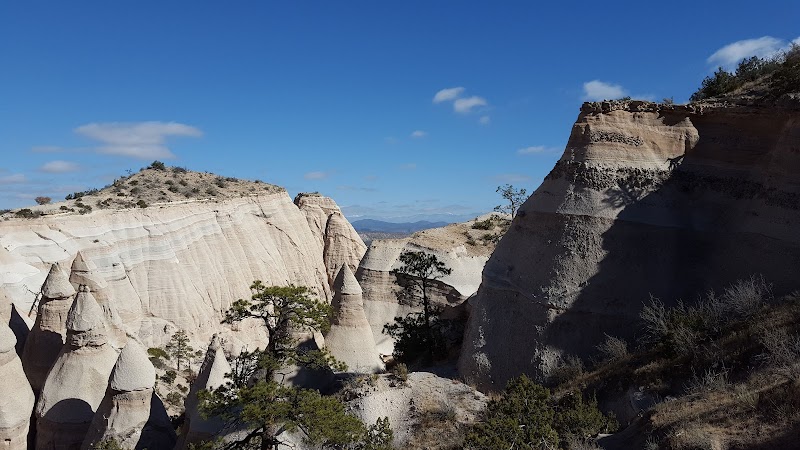
Ride the Wild: Las Vegas Mountain Bike Festival in New Mexico
The Las Vegas Mountain Bike Festival in New Mexico offers riders an exhilarating mix of rugged trails and forested climbs against the stunning Sangre de Cristo backdrop. Whether you're a seasoned cyclist or looking to challenge yourself on diverse terrain, this festival delivers adrenaline and community spirit in equal measure.
Hydrate Early and Often
Start your ride well-hydrated and carry at least 2 liters of water; the dry mountain air accelerates dehydration even before the heat builds.
Choose Appropriate Footwear
Opt for mountain bike shoes with stiff soles and good tread to handle rocky and sandy sections while providing pedal efficiency.
Plan Your Ride Timing
Kick off early morning rides to take advantage of cooler temperatures and softer light, avoiding intense afternoon sun and wind.
Protect Against Sudden Weather
Bring a lightweight waterproof layer; mountain weather can shift quickly, especially at higher elevations.
Ride the Wild: Las Vegas Mountain Bike Festival in New Mexico
Each spring, the Las Vegas Mountain Bike Festival turns the quiet town of Las Vegas, New Mexico, into a rally of wheels, trails, and wild energy. This event draws riders from all levels—beginners eager to test local singletracks and seasoned pros pushing their limits against rugged climbs and fast descents. Imagine trails weaving through ponderosa pines, the breeze carrying whispers of distant mountains and the scent of fresh earth. Here, the terrain is fiercely itself: rocky stretches daring your wheels to dance, sandy patches challenging traction, and sudden drops that invite a rush of adrenaline.
The festival centers on trails within the Santa Fe National Forest, offering routes averaging between 6 to 15 miles with elevation gains ranging 800 to 2,000 feet per ride. Whether you’re carving tight switchbacks or sprinting through open clearings, each mile promises a mixture of technical grit and sweeping vistas overlooking the Sangre de Cristo mountain range. The layered forests, alive with the chatter of birds and anxious rustle of squirrels, feel like a living opponent, not a backdrop.
Planning is key: mornings are cool and ideal for longer rides, but afternoon sun can turn the landscape stark, so timing your runs before noon delivers the best combination of light and comfort. Hydrating often is non-negotiable—trail water is scarce, but the crisp air and light elevation sap your reserves faster than you expect. Sturdy shoes with good grip, gloves to soften the jarring terrain, and a helmet that fits snugly ensure safety without sacrificing speed or control.
Off the bike, the festival hub is a mix of local culture and friendly competition. It’s a chance to meet fellow riders, pick up tips from veterans, and savor New Mexican culinary staples—from green chile stews to fresh adobe bread—which fuel you for the days ahead. Spectators enjoy side events and workshops that deepen the connection to the rugged landscape.
This is adventure on practical terms: a meeting of challenge and preparation, respect and exhilaration. For anyone serious about mountain biking in New Mexico, the Las Vegas Mountain Bike Festival is a force eagerly waited for each year, ready to test skills against a terrain that is exacting and deeply rewarding.
Nearby Trips
All Adventures
Boat Charters
Water Activities
Adventures near Las Vegas, New Mexico
Discover the unique and memorable adventures that make Las Vegas, New Mexico special.
Frequently Asked Questions
Are the trails suitable for beginners?
The festival features a range of trails. While some are beginner-friendly, most routes have technical features and elevation gain that require intermediate biking skills. Beginners should stick to shorter, less technical loops and consider joining guided group rides.
What accommodations are available nearby?
Las Vegas, NM, offers several lodging options, from rustic motels to charming B&Bs. Booking ahead during the festival is recommended, as rooms fill quickly.
Are trail maps provided during the festival?
Yes, detailed trail maps and GPS routes are handed out at registration. Volunteers are also available for briefings to help riders familiarize themselves with trail conditions and flow.
Is shuttle service available for uphill sections?
Some events provide shuttle rides to trailheads that feature longer downhill sections to conserve rider energy for the descent and technical parts.
What wildlife might I encounter on the trails?
Keep an eye out for mule deer, black bears (rarely), and a variety of birds including Steller’s jays and woodpeckers. Early morning rides increase chances of spotting wildlife.
Are there opportunities to rent bikes or gear locally?
Yes, a few shops in Las Vegas rent mountain bikes and sell gear. However, availability fluctuates during festival weekends, so securing rentals in advance is recommended.
Recommended Gear
Mountain Bike with Full Suspension
Handles rough terrain and rocky trails better, improving control and reducing rider fatigue.
Hydration Pack
Allows easy access to water during long rides, critical for high-altitude, dry conditions.
Protective Helmet
A snug, properly fitting helmet is non-negotiable for safety on challenging descents and technical spots.
Lightweight Waterproof Jacket
For sudden rain showers or cooler temperatures during spring rides.
Local Insights
Hidden Gems
- "The ‘Devil’s Throne’ viewpoint offers panoramic views with fewer crowds—best reached via a short detour from the main trail."
- "A lesser-used creek crossing near the festival grounds showcases ancient petroglyphs etched into rock faces."
Wildlife
- "Mule deer quietly traverse forest edges at dawn and dusk."
- "The elusive Montezuma quail occasionally appears in shaded clearings."
History
"Las Vegas, NM, holds rich cultural layers, blending Native American heritage with Spanish colonial influences that pioneered early trail networks still echoed in today’s routes."
